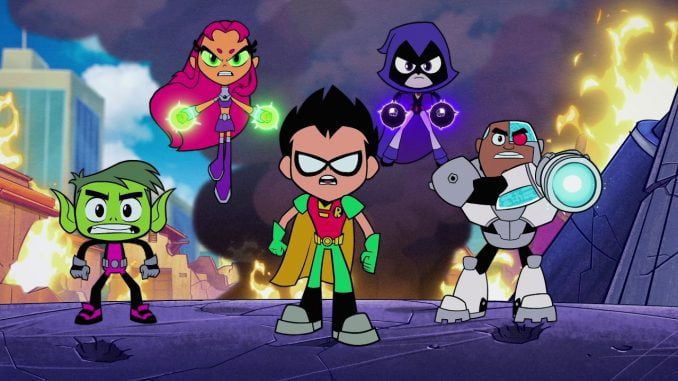
LOS ANGELES — “Teen Titans GO! to the Movies,” a brash and blithe-spirited animated comedy adventure for kids, demonstrates that when it comes to superhero movies, meta (which used to seem so, you know…meta) has become the new normal. The whole meta fixation in mainstream movies didn’t start with superhero films, of course. It probably goes back to “Scream” (1996) or even “Last Action Hero” (1993). Yet it was still startling, in 2014, to see how far “The Lego Movie” — a picture that invited three- and four-year-olds into its big tent of fun — could push the notion of look!-we’re-using-Lego-blocks-to-construct-a-fantasy-world-that- we’re-also-deconstructing-the-concept-of.
“The Lego Batman Movie” nudged the cheeky self-awareness a notch further by using it to tweak the mindset of Bruce Wayne, a rich-dude vigilante with narcissistic personality disorder who enjoyed being Batman not because he liked saving people but because he loved the image of himself as Batman. And it wouldn’t be farfetched to say that “The Lego Batman Movie” was influenced, at least a tad, by that masterstroke of meta that arrived between the first two “Lego” films: “Deadpool,” with its postmodern opening credits and snarking-outside-the-frame hero, who conspired to turn the film into a Mad-magazine parody of itself.
All of which brings us to “Teen Titans GO! to the Movies,” a film about a team of superheroes who are so avid with self-consciousness, so eagerly consumed by jabbering on about their place in the superhero firmament, that it would be hard to find a dimension of them that isn’t meta. I don’t mean to make the movie sound headier than it is. Perhaps it’s just updating the meta strategies that have long occupied the world of cartoons, whether it’s Bugs Bunny speaking directly to the audience or Rocky and Bullwinkle treating their adventures as a form of vaudeville tomfoolery, like talking-animal versions of the Marx Brothers.
Based on the Cartoon Network series that premiered in 2013 (though it has roots in DC Comics iterations going back to 1964), “Teen Titans GO! to the Movies” is the sort of film where Stan Lee pops up and says, “This is Stan Lee — dig my subtle cameo! This is a DC movie? I gotta get outta here!” In which the characters talk about how much they need an arch-nemesis. In which the closing credits are set to a synth-pop ditty called “It’s an Upbeat, Inspirational Story About Life.” And so on.
Directed by Peter Rida Michail and Aaron Horvath, from a script by Horvath and Michael Jelenic (who co-created the series), “Teen Titans GO!” has the deadpan brazenness to treat meta japery as no big whoop, but it also has the wit to turn its junior DC characters into spiky icons of kiddified kitsch. Thus, Beast Boy (Greg Cipes), who looks like a green version of Eddie Munster, can transform himself into any animal, but his real superpower is his ability to spit out white-boy-in-the-’80s-hood syllogisms like “This fool don’t know who me is!” Raven (Tara Strong), a floating girl in a phantom hood, can open portals in space and time, but her real superpower is her ability to greet threats that would spring any superhero into action with the flat affect of a “Ghost-World”-meets-Daria goth droid.
And then there’s Robin (Scott Menville). He’s the leader of the crew, and the most ordinary, without even the observational acumen that enlivens a character like Cyborg (Khary Payton). But Robin is the heart and soul of “Teen Titans GO!,” because he’s a sidekick who’s tired of his sidekick-ness — he wants to overthrow it by having an entire movie made about him. We know this because he sings a song that goes, “It’s my movie, my movie, my superhero movie! They’ll be lining up to see a movie all about me!” Sort of like the one we’re watching? Oh, well, let’s not get more meta than the filmmakers.
Amazingly, “Teen Titans GO!” has a plot that’s eerily similar to that of “Incredibles 2” — and frankly, for all the ambition of the latter film, the plot sits more comfortably in this zippy but functionally animated, glorified-TV-series context. The Titans are a team who, unlike the Justice League or the Avengers, get no respect; the movie is about how they’re fighting to be recognized as superheroes. To accomplish this, they need to publicize their skills, which they do by going up against a “mind manipulator” who pretends to be a hooded robo villain (exactly like Screenslaver) but is, in fact…well, let’s just say that you’ll swear you’re watching a rerun.
Our heroes also battle a pink gigantus named Balloon Man, whom they disarm by ripping a hole in his left buttock, which emits a flatulent air stream. That kind of takes the air out of any meta fanciness. Yet animation in our time has grown so technologically advanced that I was grateful, as I think audiences will be, to relax into the funky-punky jagged primitive landscapes of “Teen Titans GO!,” which don’t pretend to be tactile or “expressive” but are appealing for that very reason; they suggest italicized anime scrawled by the creators of “Rugrats.” The movie’s message, if it has one, is that you don’t have to be super to be a superhero. “Teen Titans GO!” is fun in a defiantly unsuper way, and that’s a recommendation.

